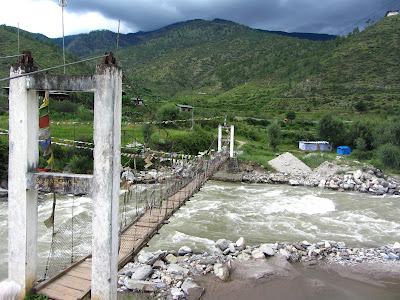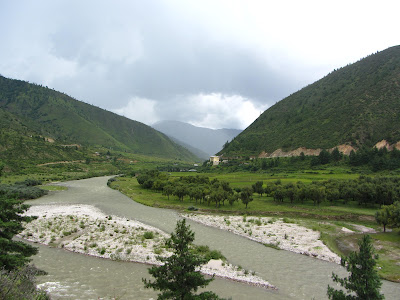Today I made my first step in procuring research sites for my dissertation. When I explain to people here exactly what my research is on – namely, inclusive education meanings and understandings in Bhutan – they almost always say: "Have you visited Draktsho?" This is interesting for a couple of different reasons.
First, Draktsho is a vocational school specifically for adolescents and young adults with moderate to severe disabilities. It is a "special school," if you will. What is interesting is that when I say, "inclusive education," people in Bhutan generally conceptualize it as meaning specifically education for persons with disabilities. 'Inclusive' means that they are included in
a school, somewhere, and not that they are included with their peers in general classrooms and schools. I'm not surprised at this association, as it is a pretty common one around the world, even in the United States. Already this is shaping how I approach my data collection.
Second, it is interesting that Draktsho is so well-known. Whenever I am referred to Draktsho, I always get the sense that people believe that Draktsho is doing good, and important, work. They seem proud that it exists. This is a positive development for persons with disabilities here, although I have not yet seen or heard of any sort of cultural or societal stigma attached to them in Bhutan.
Two of the study-abroad students from Wheaton College are actually doing an internship at Draktsho, so their advisor (and my neighbor), Jeff, asked if I would help guide their experience since he knew that was my field of expertise. While I am looking for authentically inclusive classrooms to research, I think it is important to include schools like Draktsho in the mix to get a full sense of the special education scene here. I had already been wanting to visit Draktsho, so I jumped at the opportunity to oversee the Wheaton students' experience.
I had a meeting this afternoon with the Program Manager of the school. This actually proved difficult because there is no transportation to and from RTC from about 10:30am until 3:30pm. This was also compounded by the fact that today is Tuesday and, thus, "Pedestrian Day"when all cars and half the taxis are banned from entering Thimphu. The front office at RTC arranged for an odd-numbered taxi (for today was odd-numbered taxi Tuesday) and I made it to Draktsho around 2:00pm. It cost me about Nu.400 for the trip (about $7), which seems low by American standards but on a Bhutanese budget I cannot keep doing. I will have to figured out a better transportation option if I am to go once a week.
Draktsho is located on the outskirts of the main city of Thimphu, nestled in the hills along with the Thai and Bangladeshi consulates. When I first arrived, students were congregating in front of the building and many were friendly and I even got a high-five. From what I could tell, most were students with Down's syndrome, autism, and other intellectual disabilities. From the courtyard, I walked up the steps and into the first office I could find, which turned out to be Finance and Administration. The gentlemen there were friendly and called up to the Program Manager that I have arrived.
Right away, the Program Manager (I am trying not to use names, although I've already given away the name of the school) seemed pleasant and interested in my work. She informed me that the students were on a half-day of school today, and I was startled when she explained that it was because "one of the students had expired last night." I did a double-take: "expired?" "Yes," she went on, "Very sad. It was a boy with CP [Cerebral Palsy] that choked during dinner last night. The cremation ceremony was this morning and the whole school attended."
Holy crap, I thought.
It was all very matter-of-fact. I expressed my condolences, but it felt unnecessary; perhaps this was just in reaction to the Program Manager's straight demeanor, but it could also have been a deeper cultural and Buddhist experience of death that I was feeling. Buddhists, of course, believe death to simply be an evacuation of the "soul" from the body, to be reborn again until they reach enlightenment. The body is a shell, although this is complicated a bit by the very Eastern idea of the mind and body being one and the same (as opposed to the Western-Cartesian conceptualization). Corpses are always cremated here, often openly – just as death is experienced openly here and not hidden-away like in the West. Famously, there also exists in Bhutan the practice of "sky burial." This is a Tibetan practice in which the corpse is brought to a high altitude by the family to be devoured by vultures. While this may be shocking to Westerners, the practice is
very Buddhist in that the meaningless body is returned to nature and the sense of oneness maintained. This is featured in the excellent BBC documentary,
Human Planet, which I very highly recommend.
Anyway, I digress ...
After the situation was explained by the Program Manager, we talked about my involvement with the school. I expressed my wish to visit one afternoon a week, and she agreed. The Program Manager also asked if maybe I would like to provide some expertise to the school, of which I agreed.
Draktsho is a school of about 55 students and 9 teachers. The student population ranges in age from 10-30, so it is quite a diverse group. The younger students have the subjects of Math, English, and Dzongkha and the older students are on more of a vocational track. Skills-training offered include weaving/tailoring, carving/wood working, cooking/baking, and other vocational skills. According to the Program Manager, the school has so far graduated 35 students and these students were in high-demand from businesses in Thimphu. Some of the graduates of Draktsho have gone on to work at Big Bakery which, as I think I already mentioned, employs only adults with disabilities and makes some of the best bread in town. The school does not board any students, so most live at home with their families.
Recently, Draktsho expanded to open another school in Eastern Bhutan. This school
does board students, and actually has over 70 students. One interesting thing I found out while talking to the Program Manager about Draktsho-East is that Southern and Eastern Bhutan has a much higher incidence of disability than the Western Haa-Paro-Thimphu area. She speculated that this was because alcoholism is a problem in those areas (Fetal Alcohol Syndrome), and the practice of cousins marrying was also fairly common. These are also the most rural and remote areas of Bhutan (which is already one of the most remote countries), so poor living conditions also play a huge factor in the higher disability prevalence rate. I would love to visit Eastern Bhutan and see this for myself, although it is a grueling 2-3 day drive (and, to put it in perspective, it is only about 140 miles "as the crow flies" so this should give you an idea of the terrain and difficulty of getting there).
Draktsho is entirely NGO-funded, deriving its support from organizations such as the Youth Development Fund, the Bhutan Foundation, the Tarayana Foundation, and AbilityBhutan with some initial assistance provided by JICA (the Japanese international development agency). I was surprised to learn that Draktsho receives absolutely no support from the Bhutanese government, even though it works with many of the government schools and refers students back and forth between them. The Program Manager expressed that Draktsho had limited resources, and mentioned a recent meeting with UNICEF and the UNDP (United Nations Development Program) to solicit funds.
Since school was not in session, I didn't get a full tour of the school. The Program Manager did show me the school store, where the student handicraft works were sold. There were some very nice items and I definitely made a note of items that I wanted to purchase later (it seemed awkward to purchase them at our first meeting). Draktsho, being outside of the city center, doesn't get a lot of walk-ins to its store, but they also have a shop in the Paro airport that does a good business.
In many ways, Draktsho reminded me of Bauleni School in Lusaka, Zambia, where I visited and stayed last year. Both schools were primarily designed for students with disabilities and both had a vocational focus with an entrepreneurial spirit. And, while I have mixed feelings about the segregative effects of such an environment, both Bauleni and Draktsho provide purpose and motivation for young people with disabilities in communities where they might not experience it otherwise.
...
After my meeting at Draktsho, I walked back to downtown Thimphu, which took about 20 minutes. It has been cold and rainy these past couple of days but, thankfully, it didn't rain on me. I went to Ambient Cafe to grab some coffee and banana cake – both delicious at Ambient – and ran into some of the Wheaton students hanging out there. We sat together and talked for awhile, and then I went to grab some groceries at the "8-11" store and looked as books at DSB Books, which is the best place in town to get local books on Bhutan. When I was ready to head back to RTC, I actually ran into the Wheaton students again on the street and we made it to the central bus station just in time to catch the last city bus back to RTC (as opposed to taking a taxi: a difference between Nu.25 and Nu.200).
Walking up to the bus, I heard someone shout out, "Matt!" I looked around, and to my surprise I saw my friend Noorin, who is a teacher in Punakha for the Bhutan Canada Foundation and that I had met several weeks ago (I mentioned her in a blog post awhile back). She is flying to London tomorrow for her brother's wedding, and stopped in Thimphu to buy some family gifts and stay the night before heading to Paro tomorrow. On the bus we both shared some stories about classes and education and the differences and difficulties of teaching Bhutanese students. It is always nice to talk to fellow teachers about educational issues – as anybody who has ever been in a teacher's lounge can attest!
I was grading my first essays of the semester this weekend, and it was a bit depressing. The students in Bhutan get no lessons in critical thinking, persuasive writing, or knowledge synthesis. The primary and secondary school system is very much still rooted in the old British (via Indian) educational model of rote memorization and fact regurgitation. I cannot directly fault the students for not having these skills, but I am somewhat stuck because RTC's mission is to emphasize them. So, as a teacher, I am caught in the middle of where RTC wants them and where they are.
This, alone, was not the depressing part. What is deflating is how many students innocently and blatantly plagiarize their essays. The funny part is how obvious it is, sometimes the students even forget to change the font and the copy-and-paste job jumps out at you and hits you in the face. Even though RTC has a strict academic code, it is still a widespread phenomenon. When I told Noorin about this, she put it in perspective, and it all made a lot of sense. Noorin pointed out that it was a systematic problem that begins in primary school. For example, when a primary school student is told to "write" a poem, they are encouraged to copy one from the book. Thus begins a long career of acceptable plagiarism and un-creative thinking. I'm not saying that there is any one "right" way to do it, but education has to be more than copying poems from a textbook!
I also had student essays that didn't follow even one of the clear guidelines for the assignment that I provided, essays that weren't even about the right topic, and even one essay that was overtly racist and sexist all in the same paragraph.
Today, in class, I returned their graded essays and went over some of the issues I observed and re-clarified my expectations of their written work. I hope that I at least see improvement in their next papers. I always hate to be the "bad guy" in these situations, as well as the judicator of failing grades, but I guess it has to be done from time to time. However, I'd rather let it motivate me to be a better teacher, rather than allow it to form low expectations of my students.
















































